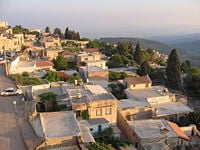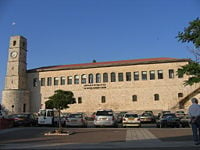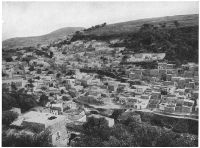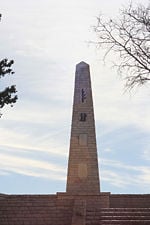Difference between revisions of "Safed" - New World Encyclopedia
m |
m (→History) |
||
| Line 20: | Line 20: | ||
==History== | ==History== | ||
| − | According to the [[Book of Judges]], the region in which Safed is located was assigned to the tribe of [[Asher]]. | + | According to the [[Book of Judges]], the region in which Safed is located was assigned to the tribe of [[Asher]]. Legend has it that Safed was founded by a son of [[Noah]] after the [[Great Flood (Biblical)|Great Flood]]. It is mentioned in the [[Talmud|Jerusalem Talmud]] as one of five elevated spots where fires were lit to announce the [[new moon]] and other festivals during the [[Second Temple]] period. However, other Jewish sources speak of its foundation dating from the second century of the common era (Yer. R. H. 58a). The city as such is not mentioned in the [[Hebrew Bible]] or the [[New Testament]]. Safed has been also been tentatively identified with ''Sepph,'' a fortified Jewish town in the [[Upper Galilee]] mentioned in the writings of the Roman Jewish historian [[Josephus]] (''Wars'' 2:573). |
| + | |||
| + | After its mention in the Talmud, there is no further mention of the town for many centuries. In the twefth century, it was a fortified [[Crusader]] city known as ''Saphet''. In 1265, the [[Mamluk]] sultan [[Baybars]] wiped out the Christian population of Sapher and turned it into the [[Muslim]] city called ''Safad'' or ''Safat''. Under the Ottomans, Safed was part of the [[vilayet]] of [[Sidon]]. | ||
| + | |||
| + | The number of Jews living there at this time is uncertain, but in 1289 Safed had a substantial enough of a Jewish community that [[Moses ben Judah ha-Kohen]] was known as the chief [[rabbi]] of the city. In that year he went to [[Tiberias]], the site of the tomb of the great Jewish philosopher [[Maimonides]] pronounced a curse of [[anathema]] on all who condemn his writings. The Jewish community of Safed was apparently not prosperous, for in 1491 the chief rabbi of Safed, Perez Colobo, who was so poorly paid that he was obliged to carry on a grocery business. This was soon to change, however, as Safed benefited from the misfortunes of Spanish Jewish were were expelled in the following year, when the community was reorganized by Joseph Saragossi, a Spanish immigrant. From this point on, the record becomes more clear. The next chief rabbi of Safed was Jacob Berab (1541), followed by the great codifier of the [[Shulchan Aruch]], [[Joseph Karo]] (1575). A [[Hebrew]] printing press was established in Safed in 1577 by [[Eliezer Ashkenazi]] and his son, [[Isaac of Prague]]. It was the first press in [[Palestine]] and the whole of the [[Ottoman Empire]]. | ||
| + | |||
| + | As a result of the influx of Jews fleeing persecution in Europe during the sixteenth and seventeenth centuries, Safed become a major center of Jewish intellectual activity and mystical thought. It was there that [[Isaac Luria]] (1534 – 1572), [[Moses Cordovero]] (1522-1570), and [[Hayyim ben Joseph Vital]] (1543 - 1620) revived Jewish interest in the Kabbala in Palestine, and [[Joseph Karo]] wrote the great compendium of [[halakha|Jewish law]] known as the ''[[Shulchan Aruch]]''. These two events would have a major impact on the attitudes and practice of [[Judaism]] for centuries to come. Moses Galante the Elder held office beginning in 1580, followed by Moses mi-Trani (1590), Joshua ben Nun (1592), Naphtali Ashkenazi (1600), Baruch Barzillai (1650), and Meïr Barzillai (1680). | ||
| + | |||
| + | The eighteenth century, however, was a period of decline, as Safed was devastated by the [[plague]] in 1742 and and earthquake in 1769. The latter compelled most of the population of Safed to emigrate to [[Damascus]] and elsewhere, so that only seven families repotedly remained, compared to nearly 10,000 Jews in 1555. In 1776 Safed was repopulated by an influx Russian Jews. Five years later two Russian rabbis, Löb Santower and Uriah of Vilna, brought there a number of families from Volhynia, Podolia, and the Ukraine. The consuls of [[Russia]] and [[Austria]] taking these foreign Jews under their protection during this period of Ottoman rule. | ||
| + | |||
| − | |||
[[Image:Safed3.jpg|thumb|200px|left|Seraya: the Ottoman fortress]] | [[Image:Safed3.jpg|thumb|200px|left|Seraya: the Ottoman fortress]] | ||
| − | + | By the end of the century, it had grown to 20,000 or 30,000. {{Fact|date=July 2008}} An outbreak of plague decimated the population in 1742 and an earthquake in 1759 left the city in ruins. An influx of [[Russian Jew]]s in 1776 and 1781, and of the [[Perushim]] in 1809 and 1810, reinvigorated the community.<ref> [[Hastening Redemption]]: Messianism and the Resettlement of the Land of Israel, Arie Morgenstern, Oxford University Press, 2007 </ref> | |
[[Image:Safed1908.jpg|thumb|200px|Muslim quarter of Safed circa 1908]] | [[Image:Safed1908.jpg|thumb|200px|Muslim quarter of Safed circa 1908]] | ||
In 1812, another plague killed 80% of the Jewish population, and in 1819 the remaining Jews were held for ransom by [[Abdullah Pasha]], the governor of [[Acre, Israel|Acre]]. On January 1, 1837, an earthquake killed 4,000 Jewish inhabitants, mostly by burying them in their homes. In 1847, plague struck Safed again. Throughout the 19th century, the Jewish community suffered from [[Bedouin]] and Arab attacks.<ref>[http://www.jafi.org.il/education/100/PLACES/safed.html Safed<!--Bot-generated title—>]</ref> | In 1812, another plague killed 80% of the Jewish population, and in 1819 the remaining Jews were held for ransom by [[Abdullah Pasha]], the governor of [[Acre, Israel|Acre]]. On January 1, 1837, an earthquake killed 4,000 Jewish inhabitants, mostly by burying them in their homes. In 1847, plague struck Safed again. Throughout the 19th century, the Jewish community suffered from [[Bedouin]] and Arab attacks.<ref>[http://www.jafi.org.il/education/100/PLACES/safed.html Safed<!--Bot-generated title—>]</ref> | ||
Revision as of 04:37, 10 December 2008
| Safed | |
 | |
| Hebrew | צְפַת |
| (Standard) | Tzfat |
| Arabic | صفد |
| Name meaning | Lookout (from the Hebrew root tzafa) |
| Government | City |
| Also spelled | Tsfat, Tzefat, Zfat, Ẕefat (officially) |
| District | North |
| Population | 28,500[1] (2007) |
| Mayor | Yishai Maimon |
Safed (Hebrew: צְפַת, Tzfat; Arabic: صفد, Safad) is a city in the Northern District of Israel. Safed is one of Judaism's Four Holy Cities, along with Jerusalem, Tiberias and Hebron, and a center for Kabbalah, or Jewish mysticism. At an elevation of 800 meters (2,660 feet) above sea level, Safed is the highest city in the Galilee.
History
According to the Book of Judges, the region in which Safed is located was assigned to the tribe of Asher. Legend has it that Safed was founded by a son of Noah after the Great Flood. It is mentioned in the Jerusalem Talmud as one of five elevated spots where fires were lit to announce the new moon and other festivals during the Second Temple period. However, other Jewish sources speak of its foundation dating from the second century of the common era (Yer. R. H. 58a). The city as such is not mentioned in the Hebrew Bible or the New Testament. Safed has been also been tentatively identified with Sepph, a fortified Jewish town in the Upper Galilee mentioned in the writings of the Roman Jewish historian Josephus (Wars 2:573).
After its mention in the Talmud, there is no further mention of the town for many centuries. In the twefth century, it was a fortified Crusader city known as Saphet. In 1265, the Mamluk sultan Baybars wiped out the Christian population of Sapher and turned it into the Muslim city called Safad or Safat. Under the Ottomans, Safed was part of the vilayet of Sidon.
The number of Jews living there at this time is uncertain, but in 1289 Safed had a substantial enough of a Jewish community that Moses ben Judah ha-Kohen was known as the chief rabbi of the city. In that year he went to Tiberias, the site of the tomb of the great Jewish philosopher Maimonides pronounced a curse of anathema on all who condemn his writings. The Jewish community of Safed was apparently not prosperous, for in 1491 the chief rabbi of Safed, Perez Colobo, who was so poorly paid that he was obliged to carry on a grocery business. This was soon to change, however, as Safed benefited from the misfortunes of Spanish Jewish were were expelled in the following year, when the community was reorganized by Joseph Saragossi, a Spanish immigrant. From this point on, the record becomes more clear. The next chief rabbi of Safed was Jacob Berab (1541), followed by the great codifier of the Shulchan Aruch, Joseph Karo (1575). A Hebrew printing press was established in Safed in 1577 by Eliezer Ashkenazi and his son, Isaac of Prague. It was the first press in Palestine and the whole of the Ottoman Empire.
As a result of the influx of Jews fleeing persecution in Europe during the sixteenth and seventeenth centuries, Safed become a major center of Jewish intellectual activity and mystical thought. It was there that Isaac Luria (1534 – 1572), Moses Cordovero (1522-1570), and Hayyim ben Joseph Vital (1543 - 1620) revived Jewish interest in the Kabbala in Palestine, and Joseph Karo wrote the great compendium of Jewish law known as the Shulchan Aruch. These two events would have a major impact on the attitudes and practice of Judaism for centuries to come. Moses Galante the Elder held office beginning in 1580, followed by Moses mi-Trani (1590), Joshua ben Nun (1592), Naphtali Ashkenazi (1600), Baruch Barzillai (1650), and Meïr Barzillai (1680).
The eighteenth century, however, was a period of decline, as Safed was devastated by the plague in 1742 and and earthquake in 1769. The latter compelled most of the population of Safed to emigrate to Damascus and elsewhere, so that only seven families repotedly remained, compared to nearly 10,000 Jews in 1555. In 1776 Safed was repopulated by an influx Russian Jews. Five years later two Russian rabbis, Löb Santower and Uriah of Vilna, brought there a number of families from Volhynia, Podolia, and the Ukraine. The consuls of Russia and Austria taking these foreign Jews under their protection during this period of Ottoman rule.
By the end of the century, it had grown to 20,000 or 30,000. [citation needed] An outbreak of plague decimated the population in 1742 and an earthquake in 1759 left the city in ruins. An influx of Russian Jews in 1776 and 1781, and of the Perushim in 1809 and 1810, reinvigorated the community.[2]
In 1812, another plague killed 80% of the Jewish population, and in 1819 the remaining Jews were held for ransom by Abdullah Pasha, the governor of Acre. On January 1, 1837, an earthquake killed 4,000 Jewish inhabitants, mostly by burying them in their homes. In 1847, plague struck Safed again. Throughout the 19th century, the Jewish community suffered from Bedouin and Arab attacks.[3] The Jewish population was increased in the last half of the 19th century by immigration from Iran, Morocco, and Algeria. Moses Montefiore visited Safed seven times and financed rebuilding of much of the town. Virtually all the antiquities of Safed were destroyed by earthquakes.
Arab-Israeli conflict
Twenty Jewish residents of Safed were murdered in the 1929 Safed massacre. In 1948, Safed was home to 12,000 Arabs. The city's 1,700 Jews were mostly religious and elderly.[4] In the Israeli War of Independence, the Arabs fled en masse, among them the family of Palestinian Authority President Mahmoud Abbas.[5][6]The city was conquered by Israeli forces on May 11, 1948.[7]In 1974, 102 Israeli Jewish teenagers from Safed on a school trip were taken hostage by a Palestinian terrorist group Democratic Front for the Liberation of Palestine (DFLP) while sleeping in a school in Maalot and 21 of them were killed .[8] In July 2006, Katyusha rockets fired by Hezbollah from Southern Lebanon hit Safed, killing one man and injuring others. On July 14, rockets killed a five-year-old boy and his grandmother. Many residents fled the town.[5] On July 22, four people were injured in a rocket attack.
Demographics
In 2008, the population of Safed was 32,000.[1] According to CBS figures in 2001, the ethnic makeup of the city was 99.2% Jewish and non-Arab, with no significant Arab population. 43.2% 1of the residents were 19 years of age or younger, 13.5% between 20 and 29, 17.1% between 30 and 44, 12.5% from 45 to 59, 3.1% from 60 to 64, and 10.5% 65 years of age or older.
Income
In December 2001, residents of Safed earned an average of 4,476 shekels per month, compared to the national average of 6,835 shekels. In 2000, there were 6,450 salaried workers and 523 self-employed. Salaried men had a mean monthly wage of NIS 5,631 (a real change of 10.2%) versus NIS 3,330 for women (a real change of 2.3%). The mean income for the self-employed was NIS 4,843. A total of 425 residents received unemployment benefits and 3,085 received income supplements.
Education
According to CBS, the city has 25 schools and 6,292 students. There are 18 elementary schools with a student population of 3,965, and 11 high schools with a student population of 2,327. 40.8% of Safed's 12th graders were eligible for a matriculation (bagrut) certificate in 2001.
Aous Shakra, a 20th century existential philosopher who taught at Harvard University, was born in Safed [citation needed].
Culture
In the 1950s and 1960s, Safed was known as Israel's art capital. The artists colony established in Safed's Old City was a hub of creativity that drew leading artists from around the country, among them Yosl Bergner, Moshe Castel and Menachem Shemi. Some of Israel's leading art galleries were located there. In honor of the opening of the Glitzenstein Art Museum in 1953, the artist Mane Katz donated eight of his paintings to the city. During this period, Safed was home to the country's top nightclubs, hosting the debut performances of Naomi Shemer, Aris San, and other acclaimed singers.[9]
See also
- Balady citron
Notes
- ↑ 1.0 1.1 Table 3 - Population of Localities Numbering Above 1,000 Residents and Other Rural Population. Israel Central Bureau of Statistics (2008-06-30). Retrieved 2008-10-18.
- ↑ Hastening Redemption: Messianism and the Resettlement of the Land of Israel, Arie Morgenstern, Oxford University Press, 2007
- ↑ Safed
- ↑ Guide to Israel, Zeev Vilnay
- ↑ 5.0 5.1 Myre, Greg. 2 More Israelis Are Killed as Rain of Rockets From Lebanon Pushes Thousands South. New York Times, July 15, 2006.
- ↑ Palestine Media Center - PMC [Official arm of PA]. "Full Israeli Withdrawal Not Enough -'Palestinians Would Never Give up 'Right of Return.'" May 16, 2005
- ↑ Guide to Israel, Zeev Vilnay
- ↑ Arafat the monster - The Boston Globe
- ↑ http://www.haaretz.com/hasen/spages/1024907.html
ReferencesISBN links support NWE through referral fees
External links

- Experience Tsfat Resource Guide (English)
- Official Site (English)
- Official Site (English&Hebrew)
| North District | ||
|---|---|---|
| Cities | Afula | Acre (Akko) | Beit She'an | Karmiel | Kiryat Shmona | Ma'alot-Tarshiha | Migdal HaEmek | Nahariya | Nazareth | Nazareth Illit | Safed | Sakhnin | Shaghur | Shefa-'Amr (Shfar'am) | Tamra | Tiberias | File:Israel north dist.png |
| Local councils | Abu Sinan | Arraba | Basmat Tiv'on | Beit Jann | Bir al-Maksur | Bu'eine Nujeidat | Buq'ata | Daburiyya | Deir Hanna | Eilabun | Ein Qiniyye | Ein Mahal | Fassuta | Ghajar | Hurfeish | Hazor HaGelilit | I'billin | Iksal | Ilut | Jadeidi-Makr | Julis | Ka'abiyye-Tabbash-Hajajre | Kabul | Kafr Kanna | Kafr Manda | Kafr Yasif | Kaokab Abu al-Hija | Katzrin | Kfar Kama | Kfar Tavor | Kfar Vradim | Kineret | Kisra-Sumei | Maghar | Majdal Shams | Mas'ada | Mashhad | Mazra'a | Metula | Mevo Hama | Migdal | Nahf | Peki'in | Rame | Reineh | Ramat Yeshi | Rosh Pinna | Sajur | Sandala | Sha'ab | Shlomi | Shibli-Umm al-Janam | Tuba-Zangariyye | Tur'an | Yafa an-Naseriyye | Yanuh-Jat | Yavne'el | Yesod HaMa'ala | Yirka | Zarzir | |
| Regional councils | Al-Batuf | Beit She'an Valley | Bustan al-Marj | Northern Jordan Valley (Emek HaYarden) | Gilboa | Golan | Jezreel Valley | Lower Galilee | Upper Galilee | Ma'ale Yosef | Matte Asher | Megiddo | Merom HaGalil | Mevo'ot HaHermon | Misgav | |
Credits
New World Encyclopedia writers and editors rewrote and completed the Wikipedia article in accordance with New World Encyclopedia standards. This article abides by terms of the Creative Commons CC-by-sa 3.0 License (CC-by-sa), which may be used and disseminated with proper attribution. Credit is due under the terms of this license that can reference both the New World Encyclopedia contributors and the selfless volunteer contributors of the Wikimedia Foundation. To cite this article click here for a list of acceptable citing formats.The history of earlier contributions by wikipedians is accessible to researchers here:
The history of this article since it was imported to New World Encyclopedia:
Note: Some restrictions may apply to use of individual images which are separately licensed.


